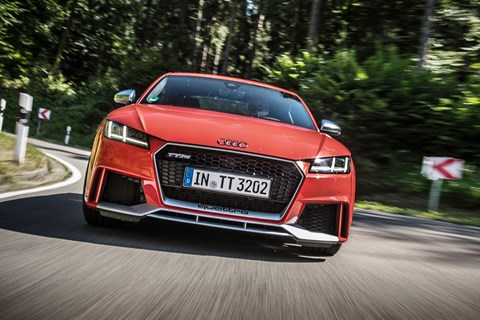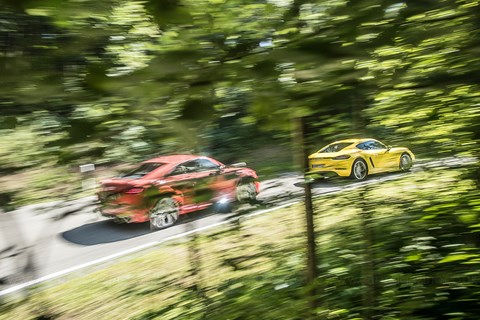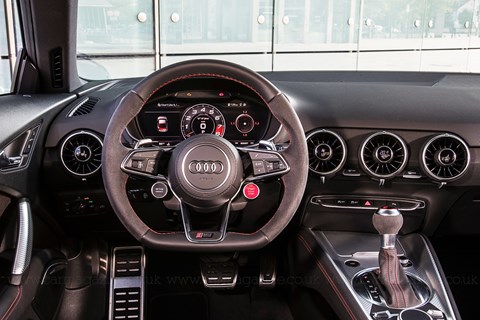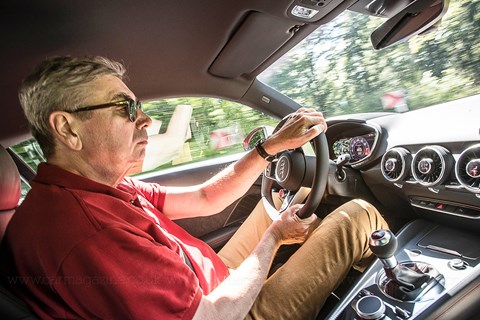► New Audi TT RS takes on Porsche’s 718 Cayman S
► Audi out-cylinders the Cayman for the first time
► Can Ingolstadt get promoted to the Bundesliga?
Hating turbocharged engines is kind of en vogue among purists these days. In 1979 when Saab introduced the blown 900 which destroyed front tyres at a vast rate of knots, and when BMW launched the 2002 Turbo which created what felt like a ten-second throttle-lag, the world could not care less about artificial aspiration.
Over 40 years later though, at the height of the turbo era and on the eve of affordable electromobility, it’s not just hardcore car guys mourning the passing of old-school drivetrains. I consider myself part of this group, and I reluctantly admit that I wanted to hate Porsche’s new forced-induction four-cylinder boxer engine, which has replaced the free-breathing six in the Boxster and Cayman.
Also for lack of thrill and enthusiasm, we have been critical of the current breed of let-me-do-this-for-you, mate, Audis. Androgynous, antiseptic and artificial are terms that come to mind when sampling these near-perfect but cold products from Ingolstadt. A case of personal preconceptions? Join us for a day of surprises, confirmations and new findings.

Anticlimax is the word that comes to mind when you twist the lozenge-shaped Porsche ignition key and start the engine the old-fashioned way. What disappoints is the noise generated behind our backs, a metallic jangle oddly reminiscent of an Oettinger-tuned Beetle from way back when: plenty of initial clatter and splutter, followed by a hoarse, uneven and atonal idle. We were hoping for a more extrovert performance, even though the tune does get catchier as you select a gear and add revs. There are 7500 revolutions to play with, plus that optional extra-loud exhaust system acting as mobile ghetto blaster, and yet your ears will primarily feast on a dense mix of high-decibel buzz and jarring rasp.
In the Audi the whiff of drama is more promising – they’ve adopted the racy steering-wheel with the big starter button4 from the R8. Hit that red dial, and feel the people who live in the same street hating you. If the explosive hard-rock intro is anything to go by, this synthesiser has all the marks of the world’s first external combustion engine.
The initial firings could jerk a baby out of its pram, and that savage overture is followed by a lingering acoustic promise that can’t wait to be fulfilled. Like our 718, the TT RS is fitted with the optional hooligan exhaust which must have been certified by the Albanian branch of Deaf & Dumb Inc. When pushed through its paces, however, the unexpectedly melodic 2.5-litre alloy-block five-ender builds up goose pimples and smiles so fast that you instinctively clench your fist. Impressive and surprising – Audi does character.

Even before we take off, the Porsche has some catching up to do. To match the specification of the Audi, it is fitted with the seven-speed PDK transmission, not the six-speed manual. In the TT RS, all you can get is a seven-speed dual-clutch gearbox. Next, please erase everything you remember about previous Caymans – because this one is different. High revs required to deliver the goods? Not anymore. At 1900rpm, the single-turbo 2497cc engine dishes up 310lb ft, and this rich torque menu is available all the way to 4500rpm. At the word go, the new four-cylinder boxer tears down the wall that used to separate cruise mode from instant grunt, which is no mean feat.
The secret to this always-on-the-alert attitude is a variable-vane wastegate turbocharger. Even at part-throttle, it whips up enough boost pressure by synchronising wastegate aperture, ignition timing and thottle blade position. As a result, the 16-valver drops the hammer hard as soon as the driver puts the foot down.
In a very wise move Audi, under former r&d chief Ulrich Hackenberg, developed a new, low-friction, high-efficiency, all-aluminium five-cylinder unit which weighs 26kg less than its cast-iron predecessor. Rated at 550bhp in the S3-derived Wörthersee concept car, it was tuned down to 395bhp in the TT RS, thereby making the planned 402bhp 2.0-litre four obsolete.
The 2480cc engine boasts an ever broader max torque band than the 345bhp kraftwerk from Zuffenhausen, spreading its peak twist action of 354lb ft from 1700 to 5850rpm. We expected an awesome punch in any gear at any time, but there was a snag. When you coast along, for example, at 60mph and suddenly feel the itch, tip-in is painfully slow since the S-tronic takes much too long to change down from fifth to third. Compared to this lengthy pause, normal turbo lag almost feels like a time-warp experience. Audi is aware of this problem and will reprogramme the software for hard and fast downshifts.

In the TT RS, seventh is normally a rev-cutting waftalong gear. In Dynamic mode, however, the black box will zoom in on the bottom six ratios. Although one can slide the shifter across to the manual gate, the steering-wheel paddles are a much more intuitive option.
We have also nothing but praise for the PDK box fitted to the 718. Dial in Sport or even Sport plus, and the Porsche will change the shift pattern in an even more dramatic fashion than the Audi. It’s all to do with how long to hold on to the gear you’re in through fast corners and at high or low revs, how to time up- and downshifts, and how to best manage the power and torque flow.
When fitted with the Sport Chrono pack, the Cayman S features a so-called Sport Response button in the middle of the rotary drive mode selector. Push it, for instance in preparation of a close overtaking manouevre, and the drivetrain switches to high alert for the next 20 seconds. Also worth noting is the coasting mode which automatically selects neutral under trailing throttle.
Despite all the marketing efforts, these two coupes are not really brand-new cars. The genetic roots of the TT RS can be traced back to Wolfsburg where VW developed the MQB architecture now also used by Audi in the 2012 A3 and the current TT. The 718 Cayman is in essence a heavily modified iteration of the original mid-engined coupe launched in 2006. If you think that’s too harsh an assessment, please consider that neither model offers mod cons such as a head-up display or sophisticated assistance systems.

While Audi is rightly proud of its versatile virtual cockpit display, Porsche has at long last introduced a decent infotainment with a new touchscreen and plenty of fresh features. Ergonomically, the latest Cayman S is nonetheless still a hotch-potch of random push, pull, turn, twist and touch commands. Some of the submenus – the Individual programme is a case in point – are awkward to access, the main dials including the digital speedometer are too small, and the centre stack is cluttered.
The TT RS is a nicer place to be in. Where the Porsche has a firewall, the Audi has two token seats which can be folded to increase the luggage space from 305 to 712 litres. It also sports more head- and legroom, easier-to-use controls and a more stylish cockpit kitted out with more modern materials.
While the car from Ingolstadt comes with quattro, S-tronic and 19in wheels, the guys from Stuttgart make you pay extra for the dual-clutch transmission and decent size footwear. As far as list prices go, the Audi’s UK price of £51,800 makes it marginally more expensive than its £48,834 PDK-equipped rival.

For the first time in its career, the 2017 Cayman is actually less expensive than the corresponding Boxster. It may not mean much, but the TT RS loses only two tenths against the R8 V10 – which costs over twice as much – in the 0-62mph trial. In the same discipline, the 718 matches the 911 Carrera which carries a 50% price premium. There is no doubt about it: the days when the number of cylinders and the displacement determined a car’s performance are over.
When speed is a drug, then this colourful couple will get you hooked for life after a single day’s hard driving – promise! One is almost always going too fast on those empty B- and C-roads in the Regensburg hinterland, and even on the unrestricted Nuremberg-Munich autobahn the fast lane was rarely clear enough to reach Vmax. The Audi normally tops 155mph, but our test car came with an extra-cost 175mph limit. Even at that velocity there was still a bit of forward thrust left.
Officially, the Cayman S will do 177mph. We saw an indicated 186mph moments before another mirrorless and indicatorless holidaymaker pulled out. Slamming on the brakes accomplished reassuring deceleration, but the freeze-frame effect was even more mind-boggling in the TT RS fitted with carbon-ceramic reins up front. The Porsche, which relied on steel rotors all-round, is also available with compound stoppers. Sadly, they cost about as much as a small farm in Swaziland.

What sets these two cars apart conceptually is one simple fact: the Porsche is a sports car, the Audi is a very sporty car. Compare, for a start, the driving positions. In the 718, you sit low down, close to the road, under a roof which is merely 1284mm tall (make that 1264mm with PASM in Sport plus). The TT RS is much easier to get in and out of, the position behind the wheel is more relaxed, the roof peaks at a less extreme 1344mm. But the Audi is clearly more A3 than R8, despite the red stitching, the fancy instruments and that fixed wing in the rear-view mirror.
What splits the hatchback coupes dynamically is the steering. The Cayman S uses the same rack as the 911 Turbo, which must be one of the most satisfying man-machine interfaces. The TT RS benefits from a variation of the MQB steering which offers three different settings, labelled Comfort, Auto and Dynamic. It’s the best r&d could do, no doubt, but it deserves only 7.5 points on the total immersion scale where the Cayman scores a solid ten.
Depending on your definition of perfection, the Audi comes close to being one of the easiest cars to be driven fast irrespective of road and surface. Instead of bothering you with too much information, it likes to act as a sublime filter with a twist. The steering is slightly over-damped, over-assisted and over-eager to step in. Somehow, it seems to have a life of 4 its own, and the mission of that life is to absorb or enhance, depending on the situation.
Through adept torque vectoring it will miraculously pull the car straight again at the exit of a bend or under hard braking into a downhill corner. No big deal, for sure. But a committed driver would be reluctant to accept any intervention, unless we’re talking true life-savers such as ABS or ESP. Once again, this Audi is struggling to fuse maximum active safety with total involvement.

The Porsche allows more leeway and provides more freedom, it still inspires confidence despite the longer leash, and it has been engineered for absolute interaction. The steering plots the tarmac with rare accuracy, even though this set-up accepts, to a certain degree, vibrations, kicks, butts and nudges. Since the communication is totally authentic, you always know exactly what the car does, and what it will likely do next. And here’s the thing: Porsche still champions the fixed steering calibration strategy over variable-this-or-that gadgetry. That’s the one parameter which can make all the difference.
The main active-safety device installed in the Audi is quattro. There is no doubt about it: in foul weather and on slippery turf, a hard-charging TT RS remains relatively unperturbed while the Cayman S has long entered phase II twitchiness. Does this focus on active safety make your heart beat faster? Probably not. Does it make the drive home less challenging? Absolutely.
Click the thumbwheel from Comfort to Sport, and the Porsche will instantly flex its muscles. Twist it one notch further to Sport Plus, and the car mentally prepares itself for an excursion to the race track. Your best bet is thus Individual, which can blend compliant dampers with a fast shifter and an eager throttle response. Better still, dial in PSM Sport which is, on cold tyres, almost as exciting as PSM Off.
If testing boundaries is all about putting abilities and ambitions into perspective, then the 718 is a better tool for the job. It is simply the more tactile car, provides feedback in abundance, talks you through the tricky bits with subtle body language, leaves some latitude before stepping in. The Cayman is happy to indulge in the complete handling spectrum from mild understeer to wild oversteer. It is a classic case of challenge followed by instant reward, or instant punishment.

Having said that, the Audi is the quicker A to B car on certain days. Its trick driveline now boasts wheel-selective torque delivery, the cornering grip of the 20in Pirelli P Zeros (the Cayman runs the same tyre) is little short of phenomenal, and in Dynamic mode more grunt can be relayed to the rear wheels in the blink of an eye. Through fast sweepers, the TT RS is surreally fast, poised and grounded. Where ripples and grooves start to annoy the Porsche, its challenger continues to be an unreservedly focused, unswerving carver.
Even though the 718 has the four-piston front brakes of the 911, it cannot quite match the fast-rewind stopping power of a TT RS with carbon-ceramic rotors. Another forte of the coupe with the four rings is the sprint against the stopwatch. Thanks to quattro, launch control and an extra 44lb ft, red beats yellow by 3.7 against 4.2sec – that’s AMG GT-S and M6 territory.
At the end of the day, it’s the handling balance which costs the Audi precious points. Turn-in just isn’t quite as eager, because eventual understeer is the name of ten-tenths cornering excercises, and because the car likes to be in control. When we entered the zig-zag rollercoaster part of the route, the TT RS started with a tyre pressure of 2.3bar all-round.
About 40 minutes later, rubber melting and brakes fuming, the readout signalled a jump to 3.3 up front and 2.6 in the back. Sure, we could have let air out and hoped for the best on the re-run. Alternatively though, Audi could have agreed on a more adventurous torque split, not unlike the set-up Ford chose for the remarkable Focus RS. After all, truly fast cornering is not about overt lariness but about a predominantly neutral attitude that stretches a bit either way when required.
On paper, these two contenders have a lot in common. On the road, however, they display quite different strengths and weaknesses. The TT RS wears a flash and aggressive outfit, but it delivers when pushed, and its dynamic potential is remarkably accessible.
The 718 Cayman S is a more complete car than last year’s GTS, and it ticks all the critical boxes, moving one more step closer to the iconic 911. Despite the paradigm shift towards the turbocharged flat-four, it still is the more emotional choice, the more engaging drive and the sole proper sports car.

Facts and figures
Audi TT RS
Price £51,800
Engine 2480cc 20v turbo inline 5-cyl, 395bhp @ 5850rpm, 354lb ft @ 1700-5850rpm
Transmission Seven-speed dual-clutch S-tronic, four-wheel drive
Suspension MacPherson strut front; multi-link rear
Performance 3.7sec 0-62mph, 174mph, 34.4mpg, 187g/km CO2
Weight 1440kg
Length/width/height 4198/1842/1344mm
On sale Now
Porsche 718 Cayman S
Price £48,834
Engine 2497cc 16v turbo 4-cyl, 345bhp @ 6500rpm, 310lb ft @ 1900-4500rpm
Transmission Seven-speed PDK, rear-wheel drive
Suspension MacPherson strut front and rear, adaptive dampers
Performance 4.2sec 0-62mph, 177mph, 38.7mpg, 167g/km CO2
Weight 1385kg
Length/width/height 4380/1801/1284mm
On sale Now
The second-hand alternatives
Used Audi TT RS from £17k
It’s because the previous – and original – TT RS was such a bahnstormer that we looked forward to the new one so much. But the new one’s breached the £50k barrier, and suddenly the original, launched in 2009 and fitted with an all-new five-pot turbo engine packing 335bhp and 332lb ft, looks a steal. £17k gets you an ’09 90k-miler, £27k bags a 2011 low-miler. The TT RS Plus from 2012 has 350bhp, but you’re looking at £36k for a tidy one.
Used Cayman S from £15k
Things that are immediately clear: 1) Porsche’s more aggressive pricing for new Cayman means Mk2 cars aren’t cheap, 2) demand for the previous, last ever non-turbo flat-six is inflating prices for Mk2s, 3) Porsche residuals beat Audi. So, a decent Mk2 Cayman S is only a ‘bargain’ in that you can get a fully loaded 2013 low-miler (carbon brakes!) for the price of a boggo Mk3 (£48k-ish). The real bargains are Mk1s: a 291bhp ’06 S, 54k miles, £14,995? You might…
Read more CAR comparison tests